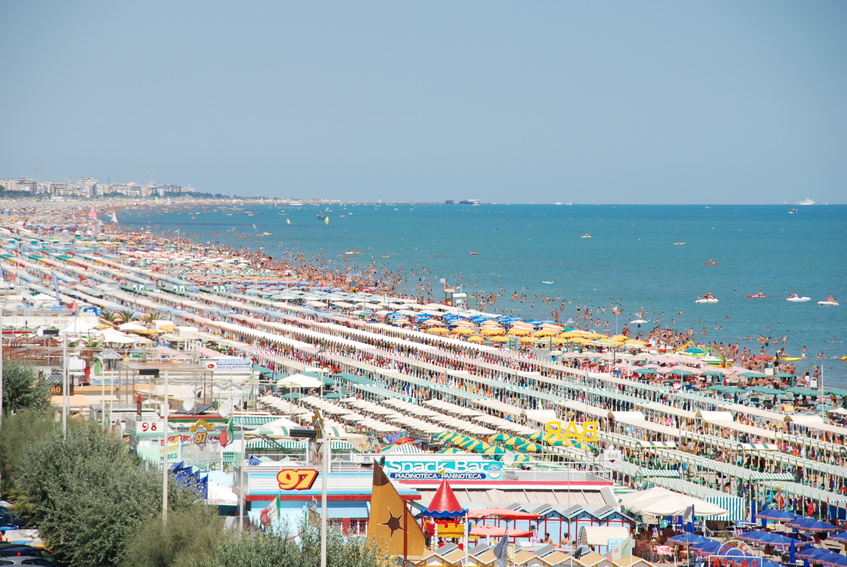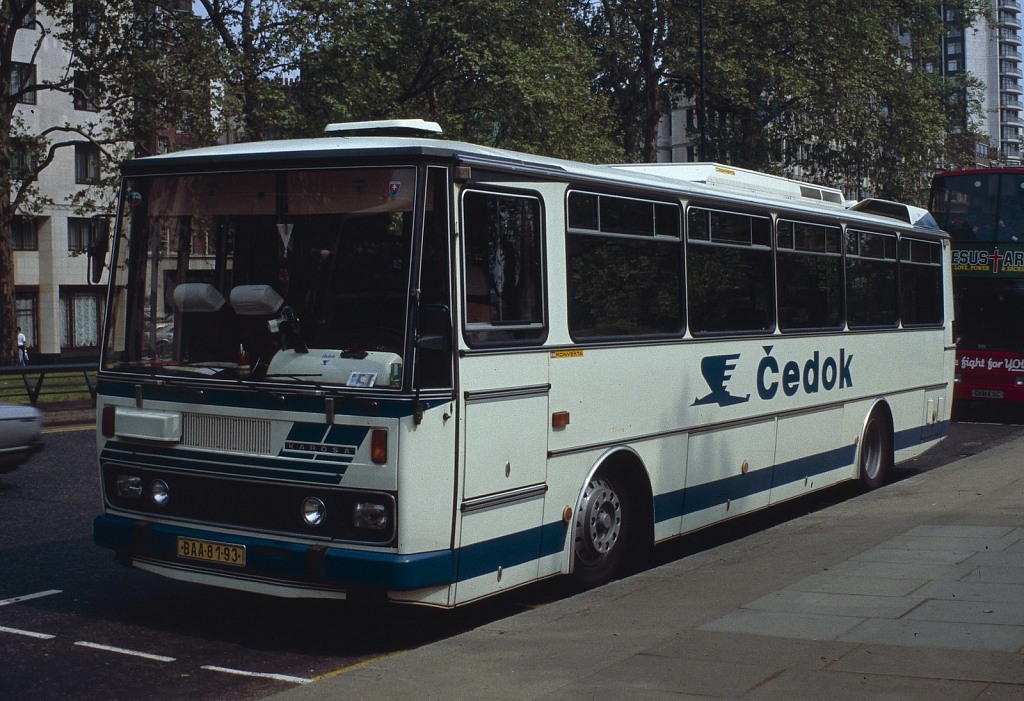Rather than mass tourism, it was an activity of collective exploration, bent mostly on saving, because at the time, most Czechs did not really have any money. It was 1990 and the average salary in Czechoslovakia did not go beyond 3,000 crown (just above 100 thousand lire at the time). A few months before, the Berlin wall had collapsed and Prague had experienced the velvet Revolution. The Czechoslovaks seized the opportunity to run to the West, pushed by the desire to know what the world was like on others side. Even at the cost of undergoing enormous strain and effort, travelling on old ramshackle buses towards the discovery of a new, rich and seductive world, but totally out of their scope.
It was under these circumstances that the mythical and creaky Karosa buses of the time took off, lining up at the customs which had finally become free. At the Cedok in that period, proposals such as: “Italy in three days” sold like pancakes. The Peninsula soon became the most popular attraction, during that summer which, back at home, had started with the notes of Notti Magiche by Gianna Nannini and Edoardo Bennato. And with the roar in the Italian stadiums at the goal scored by Toto Schillaci, but also by the Czechoslovakian centre-forward Tomas Skuhravy, top goal-scorer at Italia ’90.
It was a totally enthusiastic invasion towards the conquest of the north-east beaches and of the Romagna Riviera. But above all in Venice, city of art par excellence, the favourite destination of fleeting tourism. During that summer, until late October, the lagoon city was taken by storm every week-end by 40/50 thousand visitors from the East with the Czechoslovakians being the most numerous.
At the start of the week-end, the motor coaches used to leave in the evening from Prague, from Plzen, from Brno so as to arrive at sunrise, at times also during the night, in Rome square (Tronchetto Isle) the Venice terminal. In just a few hours the large parking area was completely full and chaotic. With few public toilettes available, queues of between 100/200 people formed, with the doors opening and closing frenetically. And slowly, as the sun began to rise, groups of people with reddened eyes – for the night spent sleeping on the bus – started to move and occupy the calli (small Venetian streets) and bridges of the Serenissima, to end up crowding San Marco Square.
“The troups of Prague are invading Venice” was one of the typical titles of that summer in 1990, to describe the city overflowing with “veterans of the defeated socialism”. The Repubblica newspaper wrote, somewhat harshly: “Breakfast time sees them queuing up with thousand lire banknotes in their hands facing the barman’s annoyed glance at the crowds lining up to have their coffees. Of that longed-for city they are only able to grasp the remnants of a deformed beauty. At lunch time, the Czechoslovaks file past the Florian to see those who take an aperitif and then, fall to the ground along the Riva degli Schiavoni, where they open their small tins of food and wrapped bread-coated slices…” And in the evening, everybody is back on the coach to cross, once more, the mountains from which they had descended.
It was in such climate that the Venice council intervened in 1990 through the Czechoslovakian embassy, but also with the embassies of Poland and Hungary in order to reach greater control on staggered departures. A member of parliament and a Christian-Democrat council advisor got to the point of saying that the Czechoslovakians did not mean business and therefore, should be kept far away so as to privilege tourists from the West.
The way in which that epic invasion of Italy took place in 1990, was also ironically represented in a film, “Slunce seno erotika”, by the director Zdeněk Troška. The hilarious vicissitudes of a group of Czechs from a little town in Bohemia, who go to Italy to start up collaboration with an Italian agricultural cooperative. A comedy full of grotesque episodes based on the habits of the Czechs of that period, but also with an ironic close attention to the Italian attitudes of the period.

Among other things, in that climate of conquest and novelty, the summer of 1990 was also one in which the Italian Latin-lovers, who were in vogue in that period, discovered the beauty of Czechoslovakian women. And it was love at first sight. An enchantment which called for an exchange of visits, with a multitude of Italian men going over there to discover the East.
“That first Italian trip of mine – an entire day in Venice and two days camping in Bibione – still remain the most unforgettable experience of my life. For me it meant freedom”, recounts Olga, a lawyer of an international Law firm located in Prague. A professional with work experience in the United States and in Switzerland, which allow her to have holidays in the most exotic countries around the world. “I went to Venice again last year for a week-end at the Hotel Cipriani. But it is not the same, it can never be the same again.”
The attempt of organizing the flow of Czech tourist towards Italy, during the early 1990s, was really a major undertaking, but it took only a few summers to realize that it had been a successful bet. “Now the Czechs – the Czechoslovakians as they are still often called – are considered special clients, but also during that far away period, in those first years, their passion for Italy and their knowledge of its culture and language was considered quite astonishing”. To recount all this, with great awareness of the facts, is Aldo Cicala, “romano de Roma”, who has been living in Prague for years and founder of the Cicala cestovni kancelar, a tour operator specialized in Italian issues who is still popular today. “At the beginning I had to deal above all with prejudice. In Lignano Sabbiadoro they told me that “tourists from the East” were not adequate clients for their structure. And being from Rome, in certain areas in the north of Italy, made things even worse. Diffidence was sky-high. And then the turnaround in Bibione, where I had the luck of finding an operator who trusted me” Cicala recounts. “In that period, the Czechs asked above all to have flats and the low season was the period in which we worked better. Our coaches – six or seven per week – went backwards and forwards to and from Italy. Mostly individual clients. In the 1990s we were able to bring to Italy around 4 to 5 thousand families during one summer. Even Cedok relied on us”, says Cicala, manifesting a certain amount of pride for believing in the prospects of that market. The Italian operators did not take long to put aside the prejudice and diffidence, above all when they started to see the first amount of money coming in. “The Czechs then used to pay with German marks and I still remember the astonishment of one Italian tourist operator when he cashed in 400 thousand German marks, one on top of the other, as a down payment for the flats”.
Prejudice was not only one-sided. “At the time, the Czechoslovakian television used to transmit La Piovra – the Mafia serial. During the first period, a few clients avoided going to Italy with their Skoda vintage cars, for fear that some Mafia people might steal their car … Therefore, they preferred the bus or the train” says Cicala laughingly.
Twenty years have passed since that period and it is incredible the speed with which many things have changed. Italy remains one of the most desired tourist areas, but the catalogues of the Czech tourist operators have now become glossy and travelling by plane to all the destinations of the world is now common place. It is now the Czechs who are becoming fussier, above all, towards Italian students who, with their so called “educational trips”, crowd the streets of Prague during the low-season winter months. In the same way that in our country we used to write about the tourists from the East on the Rialto Bridge, it is now the Czech papers that are writing about the Italian students on the Charles Bridge, with a great amount of prejudice which comes and goes. It is a moral of history – always the same and which we should be able to grasp.
by Giovanni Usai





